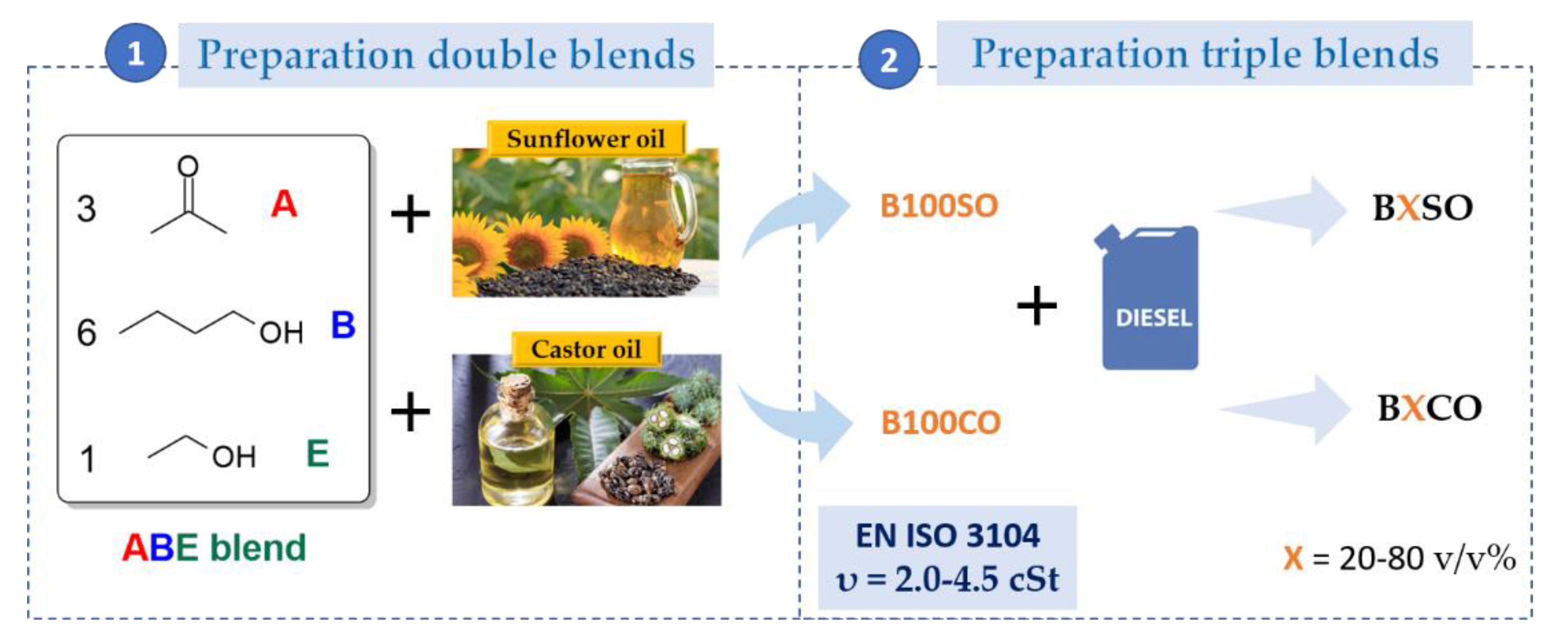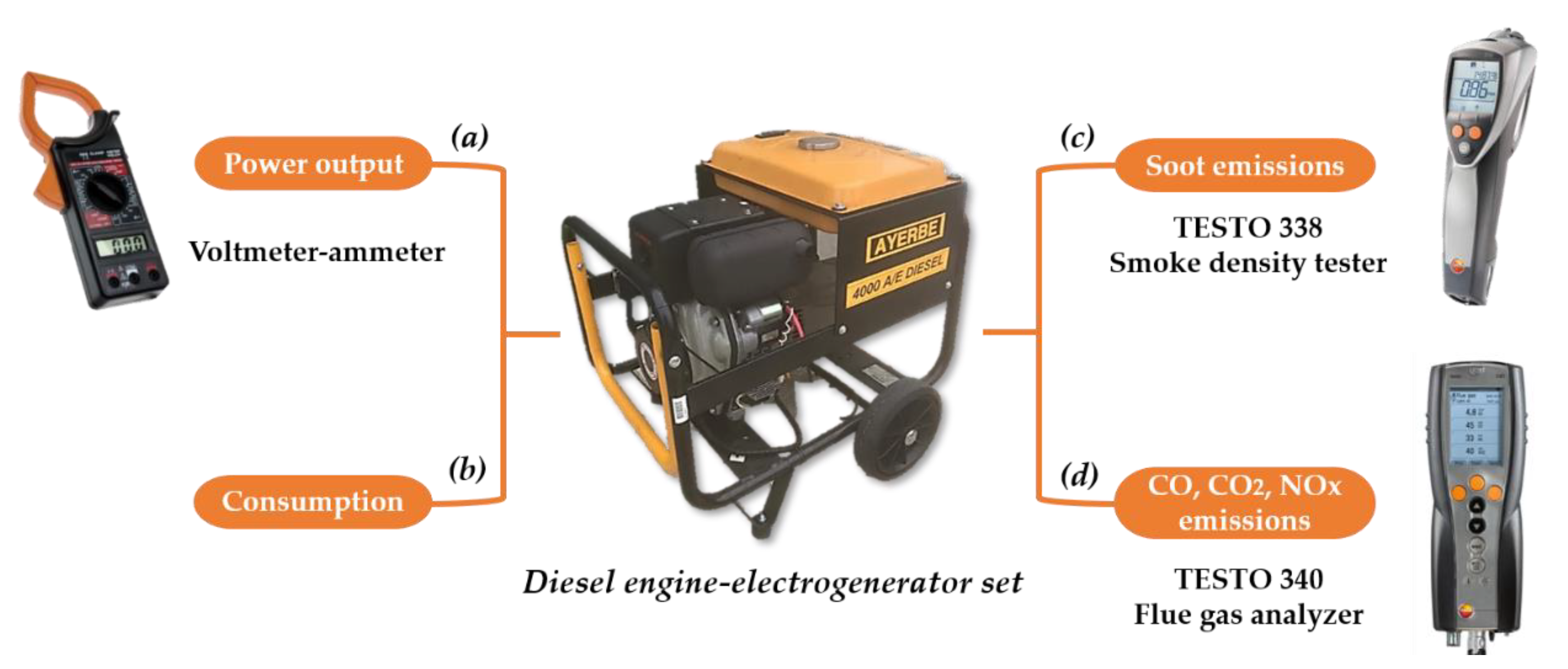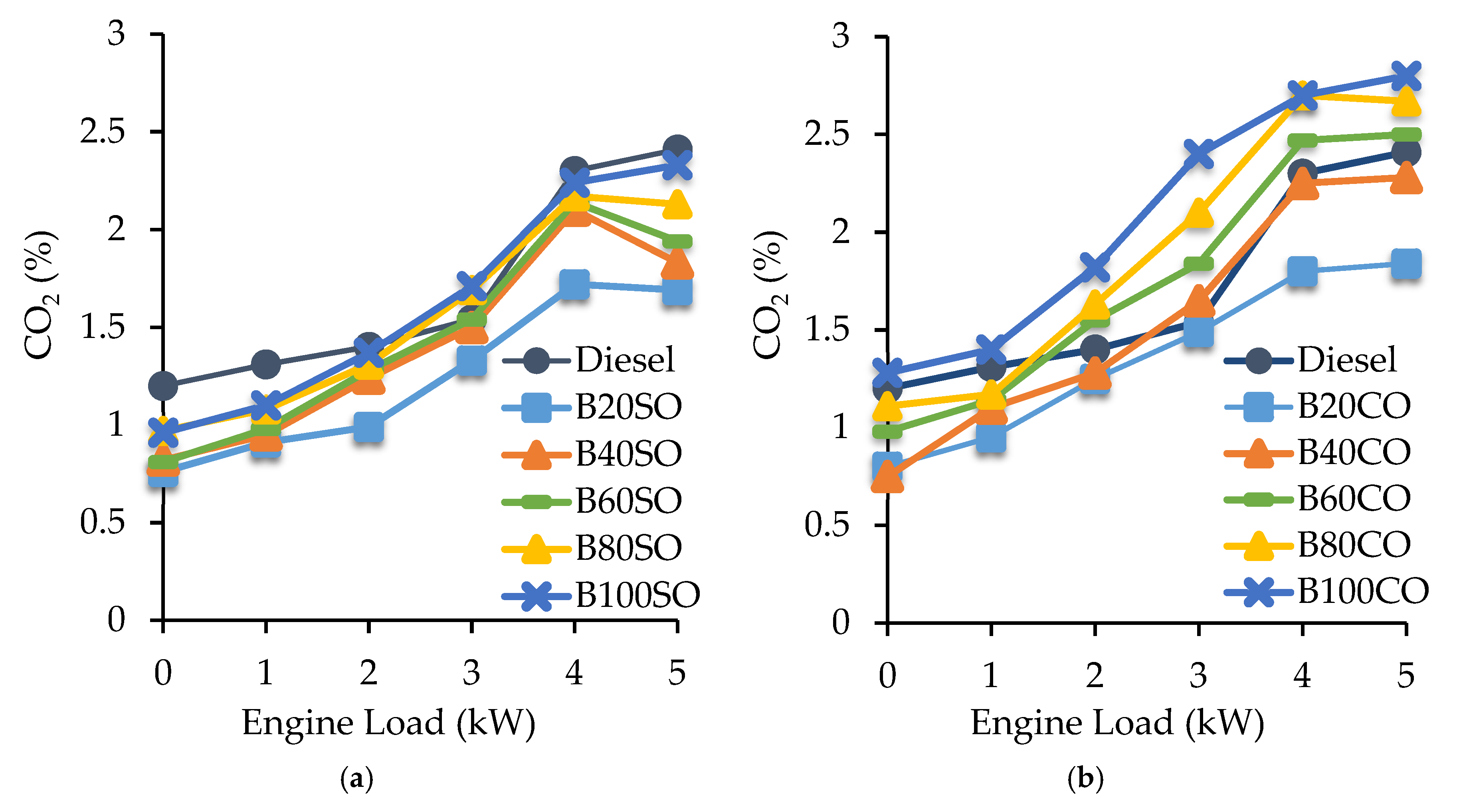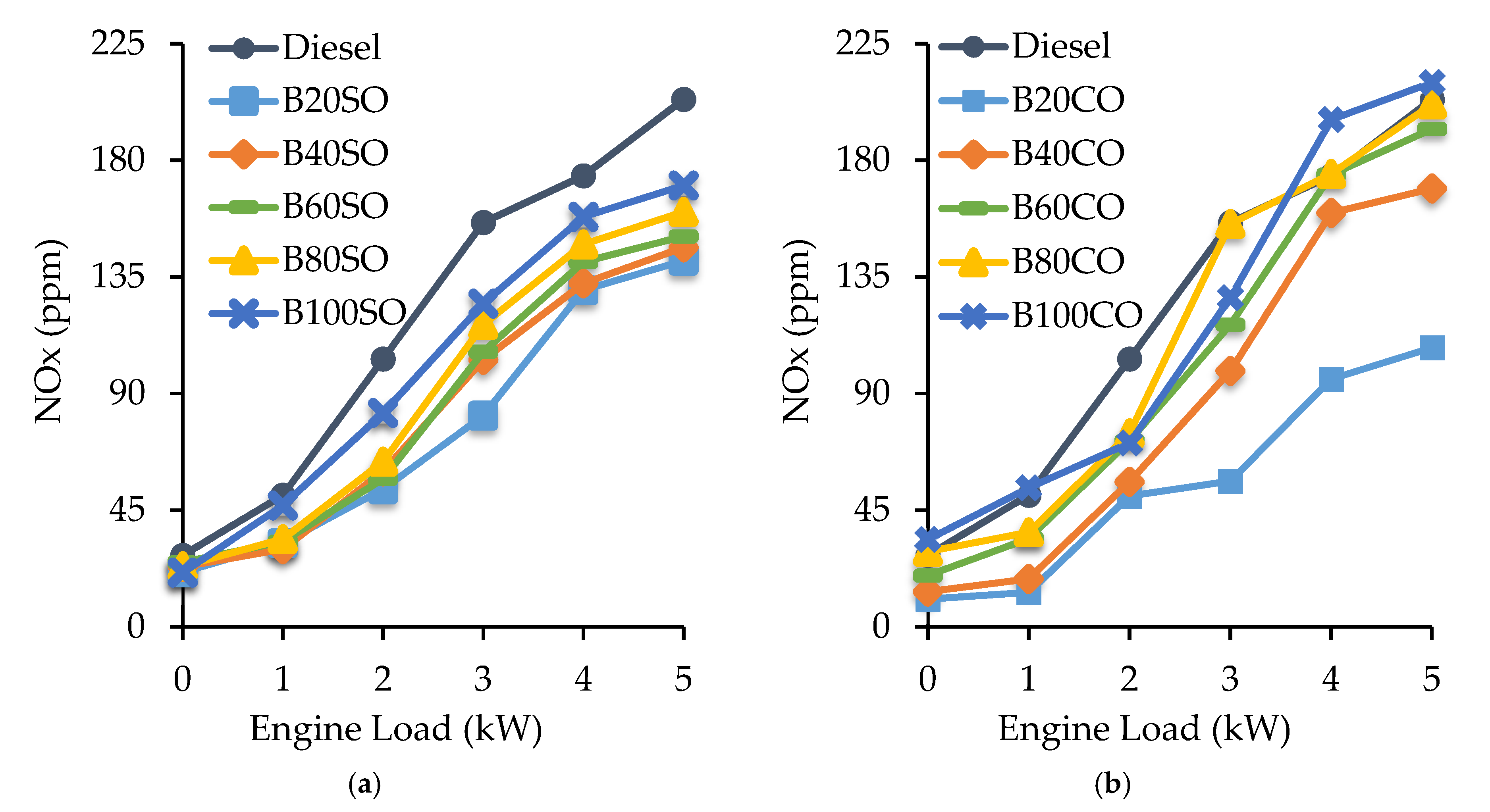Advanced Biofuels from ABE (Acetone/Butanol/Ethanol) and Vegetable Oils (Castor or Sunflower Oil) for Using in Triple Blends with Diesel: Evaluation on a Diesel Engine
Abstract
:1. Introduction
2. Materials and Methods
2.1. Preparation of ABE/Vegetable Oil Double Blend and Diesel/ABE/Vegetable Oil Triple Blends
2.2. Physico-Chemical Characterization of the Biofuel Blends
2.3. Performance and Exhaust Emissions of a Diesel Engine Electric Generator Fueled with the Different ABE/SVO Double and Diesel/ABE/SVO Triple Blends
3. Results and Discussion
3.1. Physico-Chemical Properties of ABE/SVO Double Blends, and D/ABE/SVO Triple Blends
3.2. Mechanical Performance of a Diesel Engine Fueled with the Different (Bio)Fuel Blends
3.3. Brake-Specific Fuel Consumption (BSFC)
3.4. Exhaust Emissions from Diesel Engine
3.4.1. Soot Emissions
3.4.2. Carbon Monoxide (CO) Emissions
3.4.3. Carbon Dioxide (CO2) Emissions
3.4.4. Nitrogen Oxides (NOx) Emissions
3.4.5. Comparison with Previous Results
4. Conclusions
Author Contributions
Funding
Institutional Review Board Statement
Informed Consent Statement
Acknowledgments
Conflicts of Interest
References
- Gota, S.; Huizenga, C.; Peet, K.; Medimorec, N.; Bakker, S. Decarbonising transport to achieve Paris Agreement targets. Energy Effic. 2019, 12, 363–386. [Google Scholar] [CrossRef]
- Kalghatgi, G. Is it really the end of internal combustion engines and petroleum in transport? Appl. Energy 2018, 225, 965–974. [Google Scholar] [CrossRef]
- Pietrzak, K.; Pietrzak, O. Environmental effects of electromobility in a sustainable urban public transport. Sustainability 2020, 12, 1052. [Google Scholar] [CrossRef]
- Al-dal’ain, R.; Celebi, D. Planning a mixed fleet of electric and conventional vehicles for urban freight with routing and replacement considerations. Sustain. Cities Soc. 2021, 73, 103105. [Google Scholar] [CrossRef]
- Jeswani, H.K.; Chilvers, A.; Azapagic, A. Environmental sustainability of biofuels: A review: Environmental sustainability of biofuels. Proc. R. Soc. A Math. Phys. Eng. Sci. 2020, 476, 1–37. [Google Scholar] [CrossRef]
- Benjamin, M.F.D.; Andiappan, V.; Lee, J.Y.; Tan, R.R. Increasing the reliability of bioenergy parks utilizing agricultural waste feedstock under demand uncertainty. J. Clean. Prod. 2020, 269, 122385. [Google Scholar] [CrossRef]
- Nwufo, O.C.; Nwafor, O.M.I.; Igbokwe, O.J. Effects of blends on the physical properties of bioethanol produced from selected Nigerian crops. Int. J. Ambient Energy 2016, 37, 10–15. [Google Scholar] [CrossRef]
- Hellier, P.; Ladommatos, N.; Yusaf, T. The influence of straight vegetable oil fatty acid composition on compression ignition combustion and emissions. Fuel 2015, 143, 131–143. [Google Scholar] [CrossRef]
- Luque, R.; Herrero-Davila, L.; Campelo, J.M.; Clark, J.H.; Hidalgo, J.M.; Luna, D.; Marinas, J.M.; Romero, A.A. Biofuels: A technological perspective. Energy Environ. Sci. 2008, 1, 542–564. [Google Scholar] [CrossRef]
- Estevez, R.; Aguado-Deblas, L.; Bautista, F.M.; Luna, D.; Luna, C.; Calero, J.; Posadillo, A.; Romero, A.A. Biodiesel at the crossroads: A critical review. Catalysts 2019, 9, 1033. [Google Scholar] [CrossRef] [Green Version]
- Calero, J.; Luna, D.; Sancho, E.D.; Luna, C.; Bautista, F.M.; Romero, A.A.; Posadillo, A.; Berbel, J.; Verdugo-Escamilla, C. An overview on glycerol-free processes for the production of renewable liquid biofuels, applicable in diesel engines. Renew. Sustain. Energy Rev. 2015, 42, 1437–1452. [Google Scholar] [CrossRef]
- Ribeiro, J.S.; Celante, D.; Brondani, L.N.; Trojahn, D.O.; da Silva, C.; de Castilhos, F. Synthesis of methyl esters and triacetin from macaw oil (Acrocomia aculeata) and methyl acetate over γ-alumina. Ind. Crops Prod. 2018, 124, 84–90. [Google Scholar] [CrossRef]
- Abdulkareem-Alsultan, G.; Asikin-Mijan, N.; Lee, H.V.; Rashid, U.; Islam, A.; Taufiq-Yap, Y.H. Review on thermal conversion of plant oil (Edible and inedible) into green fuel using carbon-based nanocatalyst. Catalysts 2019, 9, 350. [Google Scholar] [CrossRef]
- Hongloi, N.; Prapainainar, P.; Prapainainar, C. Review of green diesel production from fatty acid deoxygenation over Ni-based catalysts. Mol. Catal. 2022, 523, 111696. [Google Scholar] [CrossRef]
- Douvartzides, S.L.; Charisiou, N.D.; Papageridis, K.N.; Goula, M.A. Green diesel: Biomass feedstocks, production technologies, catalytic research, fuel properties and performance in compression ignition internal combustion engines. Energies 2019, 12, 809. [Google Scholar] [CrossRef]
- Vallinayagam, R.; Vedharaj, S.; Yang, W.M.; Roberts, W.L.; Dibble, R.W. Feasibility of using less viscous and lower cetane (LVLC) fuels in a diesel engine: A review. Renew. Sustain. Energy Rev. 2015, 51, 1166–1190. [Google Scholar] [CrossRef]
- Prakash, T.; Geo, V.E.; Martin, L.J.; Nagalingam, B. Evaluation of pine oil blending to improve the combustion of high viscous (castor oil) biofuel compared to castor oil biodiesel in a CI engine. Heat Mass Transf. 2019, 55, 1491–1501. [Google Scholar] [CrossRef]
- Vallinayagam, R.; Vedharaj, S.; Yang, W.M.; Lee, P.S.; Chua, K.J.E.; Chou, S.K. Pine oil-biodiesel blends: A double biofuel strategy to completely eliminate the use of diesel in a diesel engine. Appl. Energy 2014, 130, 466–473. [Google Scholar] [CrossRef]
- Kasiraman, G.; Nagalingam, B.; Balakrishnan, M. Performance, emission and combustion improvements in a direct injection diesel engine using cashew nut shell oil as fuel with camphor oil blending. Energy 2012, 47, 116–124. [Google Scholar] [CrossRef]
- Martin, M.L.J.; Geo, V.E.; Singh, D.K.J.; Nagalingam, B. A comparative analysis of different methods to improve the performance of cotton seed oil fuelled diesel engine. Fuel 2012, 102, 372–378. [Google Scholar] [CrossRef]
- Krishnamoorthy, V.; Dhanasekaran, R.; Rana, D.; Saravanan, S.; Kumar, B.R. A comparative assessment of ternary blends of three bio-alcohols with waste cooking oil and diesel for optimum emissions and performance in a CI engine using response surface methodology. Energy Convers. Manag. 2018, 156, 337–357. [Google Scholar] [CrossRef]
- Atmanli, A.; Ileri, E.; Yuksel, B.; Yilmaz, N. Extensive analyses of diesel-vegetable oil-n-butanol ternary blends in a diesel engine. Appl. Energy 2015, 145, 155–162. [Google Scholar] [CrossRef]
- Coughlin, B.; Hoxie, A. Combustion characteristics of ternary fuel Blends: Pentanol, butanol and vegetable oil. Fuel 2017, 196, 488–496. [Google Scholar] [CrossRef]
- Hurtado, B.; Posadillo, A.; Luna, D.; Bautista, F.M.; Hidalgo, J.M.; Luna, C.; Calero, J.; Romero, A.A.; Estevez, R. Synthesis, performance and emission quality assessment of ecodiesel from castor oil in diesel/biofuel/alcohol triple blends in a diesel engine. Catalysts 2019, 9, 40. [Google Scholar] [CrossRef]
- Kumar, A.; Rajan, K.; Kumar, K.R.S.; Maiyappan, K.; Rasheed, U.T. Green fuel utilization for diesel engine, combustion and emission analysis fuelled with CNSO diesel blends with Diethyl ether as additive. IOP Conf. Ser. Mater. Sci. Eng. 2017, 197, 012013. [Google Scholar] [CrossRef]
- Kumar, A.; Rajan, K.; Naraynan, M.R.; Kumar, K.R.S. Performance and Emission Characteristics of a Di Diesel Engine Fuelled with Cashew Nut Shell Oil (CNSO)-Diesel Blends with Diethyl Ether as Additive. Appl. Mech. Mater. 2015, 787, 746–750. [Google Scholar] [CrossRef]
- Rakopoulos, D.C.; Rakopoulos, C.D.; Kyritsis, D.C. Butanol or DEE blends with either straight vegetable oil or biodiesel excluding fossil fuel: Comparative effects on diesel engine combustion attributes, cyclic variability and regulated emissions trade-off. Energy 2016, 115, 314–325. [Google Scholar] [CrossRef]
- Krishnamoorthi, M.; Malayalamurthi, R. Experimental investigation on the availability, performance, combustion and emission distinctiveness of bael oil/ diesel/ diethyl ether blends powered in a variable compression ratio diesel engine. Heat Mass Transf. 2018, 54, 2023–2044. [Google Scholar] [CrossRef]
- Aguado-Deblas, L.; Hidalgo-Carrillo, J.; Bautista, F.M.; Luna, D.; Luna, C.; Calero, J.; Posadillo, A.; Romero, A.A.; Estevez, R. Diethyl ether as an oxygenated additive for fossil diesel/vegetable oil blends: Evaluation of performance and emission quality of triple blends on a diesel engine. Energies 2020, 13, 1542. [Google Scholar] [CrossRef]
- Krishnamoorthi, M.; Malayalamurthi, R. Combined Effect of Compression Ratio, Injection Pressure, and Injection Timing on Performance and Emission of a di Compression Ignition Engine Fueled with Diesel-Aegle Marmelos Oil-Diethyl Ether Blends Using Response Surface Methodology. Energy Fuels 2017, 31, 11362–11376. [Google Scholar] [CrossRef]
- Jones, R.U.S. Ethyl Acetate as Fuel or Fuel Additive. U.S. Patent 12/792,867, 12 August 2011. [Google Scholar]
- Aguado-Deblas, L.; Estevez, R.; Hidalgo-Carrillo, J.; Bautista, F.M.; Luna, C.; Calero, J.; Posadillo, A.; Romero, A.A.; Luna, D. Outlook for direct use of sunflower and castor oils as biofuels in compression ignition diesel engines, being part of diesel/ethyl acetate/straight vegetable oil triple blends. Energies 2020, 13, 4836. [Google Scholar] [CrossRef]
- Aguado-Deblas, L.; Hidalgo-Carrillo, J.; Bautista, F.M.; Luna, C.; Calero, J.; Posadillo, A.; Romero, A.A.; Luna, D.; Estévez, R. Biofuels from diethyl carbonate and vegetable oils for use in triple blends with diesel fuel: Effect on performance and smoke emissions of a diesel engine. Energies 2020, 13, 6584. [Google Scholar] [CrossRef]
- Aguado-Deblas, L.; Hidalgo-Carrillo, J.; Bautista, F.M.; Luna, C.; Calero, J.; Posadillo, A.; Romero, A.A.; Luna, D.; Estévez, R. Evaluation of dimethyl carbonate as alternative biofuel. performance and smoke emissions of a diesel engine fueled with diesel/dimethyl carbonate/straight vegetable oil triple blends. Sustainability 2021, 13, 1749. [Google Scholar] [CrossRef]
- Aguado-Deblas, L.; Hidalgo-Carrillo, J.; Bautista, F.M.; Luna, D.; Luna, C.; Calero, J.; Posadillo, A.; Romero, A.A.; Estevez, R. Acetone prospect as an additive to allow the use of castor and sunflower oils as drop-in biofuels in diesel/acetone/vegetable oil triple blends for application in diesel engines. Molecules 2020, 25, 2935. [Google Scholar] [CrossRef]
- Jin, C.; Yao, M.; Liu, H.; Lee, C.F.F.; Ji, J. Progress in the production and application of n-butanol as a biofuel. Renew. Sustain. Energy Rev. 2011, 15, 4080–4106. [Google Scholar] [CrossRef]
- Lujaji, F.; Kristóf, L.; Bereczky, A.; Mbarawa, M. Experimental investigation of fuel properties, engine performance, combustion and emissions of blends containing croton oil, butanol, and diesel on a CI engine. Fuel 2011, 90, 505–510. [Google Scholar] [CrossRef]
- Guarieiro, L.L.N.; de Souza, A.F.; Torres, E.A.; de Andrade, J.B. Emission profile of 18 carbonyl compounds, CO, CO2, and NOx emitted by a diesel engine fuelled with diesel and ternary blends containing diesel, ethanol and biodiesel or vegetable oils. Atmos. Environ. 2009, 43, 2754–2761. [Google Scholar] [CrossRef]
- Atmanli, A. Effects of a cetane improver on fuel properties and engine characteristics of a diesel engine fueled with the blends of diesel, hazelnut oil and higher carbon alcohol. Fuel 2016, 172, 209–217. [Google Scholar] [CrossRef]
- Atmanli, A.; Ileri, E.; Yilmaz, N. Optimization of diesel-butanol-vegetable oil blend ratios based on engine operating parameters. Energy 2016, 96, 569–580. [Google Scholar] [CrossRef]
- Atmanli, A.; Yüksel, B.; Ileri, E.; Karaoglan, A.D. Response surface methodology based optimization of diesel-n-butanol -cotton oil ternary blend ratios to improve engine performance and exhaust emission characteristics. Energy Convers. Manag. 2015, 90, 383–394. [Google Scholar] [CrossRef]
- Atmanli, A.; Ileri, E.; Yüksel, B. Effects of higher ratios of n-butanol addition to diesel-vegetable oil blends on performance and exhaust emissions of a diesel engine. J. Energy Inst. 2015, 88, 209–220. [Google Scholar] [CrossRef]
- Atmanli, A.; Ileri, E.; Yüksel, B. Experimental investigation of engine performance and exhaust emissions of a diesel engine fueled with diesel-n-butanol-vegetable oil blends. Energy Convers. Manag. 2014, 81, 312–321. [Google Scholar] [CrossRef]
- Atmanli, A.; Yüksel, B.; Ileri, E. Experimental investigation of the effect of diesel-cotton oil-n-butanol ternary blends on phase stability, engine performance and exhaust emission parameters in a diesel engine. Fuel 2013, 109, 503–511. [Google Scholar] [CrossRef]
- Veza, I.; Said, M.F.M.; Latiff, Z.A. Recent advances in butanol production by acetone-butanol-ethanol (ABE) fermentation. Biomass Bioenergy 2021, 144, 105919. [Google Scholar] [CrossRef]
- Veza, I.; Said, M.F.M.; Latiff, Z.A. Progress of acetone-butanol-ethanol (ABE) as biofuel in gasoline and diesel engine: A review. Fuel Process. Technol. 2019, 196, 106179. [Google Scholar] [CrossRef]
- Algayyim, S.J.M.; Wandel, A.P.; Yusaf, T.; Hamawand, I. Production and application of ABE as a biofuel. Renew. Sustain. Energy Rev. 2018, 82, 1195–1214. [Google Scholar] [CrossRef]
- Li, Y.; Tang, W.; Chen, Y.; Liu, J.; Lee, C.F.F. Potential of acetone-butanol-ethanol (ABE) as a biofuel. Fuel 2019, 242, 673–686. [Google Scholar] [CrossRef]
- Gui, M.M.; Lee, K.T.; Bhatia, S. Feasibility of edible oil vs. non-edible oil vs. waste edible oil as biodiesel feedstock. Energy 2008, 33, 1646–1653. [Google Scholar] [CrossRef]
- Krishnamoorthi, M.; Malayalamurthi, R. Experimental investigation on performance, emission behavior and exergy analysis of a variable compression ratio engine fueled with diesel-aegle marmelos oil-diethyl ether blends. Energy 2017, 128, 312–328. [Google Scholar] [CrossRef]
- Algayyim, S.J.M.; Wandel, A.P. Performance and emission levels of butanol, acetone-butanol-ethanol, butanol-acetone/diesel blends in a diesel engine. Biofuels 2022, 13, 449–459. [Google Scholar] [CrossRef]
- Algayyim, S.J.; Wandel, A.P.; Yusaf, T.; Hamawand, I.; Al-Wayzy, S. Experimental study of spray characteristics, engine performance and emission levels of acetone-butanol-ethanol mixture-diesel blends in a diesel engine. In Proceedings of the 11th Asia-Pacific Conference on Combustion ASPACC 2017, Sydney, Australia, 10–14 December 2017; pp. 1–4. [Google Scholar]
- Blends, A.-B.-E.D.; Lee, T.H.; Lin, Y.; Nithyanandan, K.; Li, Y.; Hansen, A.C. Experimental investigation of a diesel engine fuelled with acetone-butanol-ethanol/ diesel blends. In Proceedings of the ICEF2015-1148, Houston, TX, USA, 8–11 November 2015; pp. 1–9. [Google Scholar]
- Venugopal, T.; Ramesh, A. Effective utilisation of butanol along with gasoline in a spark ignition engine through a dual injection system. Appl. Therm. Eng. 2013, 59, 550–558. [Google Scholar] [CrossRef]
- Chang, Y.C.; Lee, W.J.; Wu, T.S.; Wu, C.Y.; Chen, S.J. Use of water containing acetone-butanol-ethanol for NOx-PM (nitrogen oxide-particulate matter) trade-off in the diesel engine fueled with biodiesel. Energy 2014, 64, 678–687. [Google Scholar] [CrossRef]
- Salamanca, M.; Mondragón, F.; Agudelo, J.R.; Benjumea, P.; Santamaría, A. Variations in the chemical composition and morphology of soot induced by the unsaturation degree of biodiesel and a biodiesel blend. Combust. Flame 2012, 159, 1100–1108. [Google Scholar] [CrossRef]
- Chang, Y.C.; Lee, W.J.; Lin, S.L.; Wang, L.C. Green energy: Water-containing acetone-butanol-ethanol diesel blends fueled in diesel engines. Appl. Energy 2013, 109, 182–191. [Google Scholar] [CrossRef]
- Hoekman, S.K.; Robbins, C. Review of the effects of biodiesel on NOx emissions. Fuel Process. Technol. 2012, 96, 237–249. [Google Scholar] [CrossRef]
- Prakash, T.; Geo, V.E.; Martin, L.J.; Nagalingam, B. Effect of ternary blends of bio-ethanol, diesel and castor oil on performance, emission and combustion in a CI engine. Renew. Energy 2018, 122, 301–309. [Google Scholar] [CrossRef]
- Kumar, S.; Cho, J.H.; Park, J.; Moon, I. Advances in diesel-alcohol blends and their effects on the performance and emissions of diesel engines. Renew. Sustain. Energy Rev. 2013, 22, 46–72. [Google Scholar] [CrossRef]
- Ghadikolaei, M.A.; Wong, P.K.; Cheung, C.S.; Ning, Z.; Yung, K.F.; Zhao, J.; Gali, N.K.; Berenjestanaki, A.V. Impact of lower and higher alcohols on the physicochemical properties of particulate matter from diesel engines: A review. Renew. Sustain. Energy Rev. 2021, 143, 110970. [Google Scholar] [CrossRef]
- Fernández-Rodríguez, D.; Lapuerta, M.; German, L. Progress in the use of biobutanol blends in diesel engines. Energies 2021, 14, 3215. [Google Scholar] [CrossRef]
- Giakoumis, E.G.; Rakopoulos, C.D.; Dimaratos, A.M.; Rakopoulos, D.C. Exhaust emissions with ethanol or n-butanol diesel fuel blends during transient operation: A review. Renew. Sustain. Energy Rev. 2013, 17, 170–190. [Google Scholar] [CrossRef]
- Mumpuni, S.; Rahaju, N.; Veza, I.; Tamaldin, N.; Sule, A.; Opia, A.C.; Abdulrahman, M.B.; Djamari, D.W. Acetone-Butanol-Ethanol as the Next Green Biofuel—A Review. Automot. Exp. 2022, 5, 251–260. [Google Scholar]
- Lin, Y.; Lee, T.; Nithyanandan, K.; Zhang, J.; Li, Y.; Lee, C.F. Experimental Investigation and Analysis of Combustion Process in a Diesel Engine Fueled with Acetone-Butanol-Ethanol/Diesel Blends. SAE Technical Paper. In Proceedings of the SAE 2016 World Congress and Exhibition, Detroit, MI, USA, 12–14 April 2016. [Google Scholar] [CrossRef]








| Model | AYERBE 4000 Diesel |
|---|---|
| Alternator | LINZ-SP 10MF 4.2 KVA |
| Engine | YANMAR LN-70 |
| Type | Vertical cylinder, 4-cycle, air-cooled diesel engine |
| Combustion | Direct injection |
| Bore × Stroke | 78 × 67 mm |
| Displacement | 320 cm3 |
| Horsepower | 6.7 |
| Rated power output | 4.5 kW/3000 rpm |
| Voltage | 230 V |
| Fuel consumption | 1.3 L/H (75%) |
| Parameter | Measuring Range | Accuracy |
|---|---|---|
| Soot | 0.0–2.5 (Bosch Number); 0 to 50 mg/m3 | ±0.5 mg/m3 |
| CO | 0–10,000 ppm | ±10 ppm (0–200 ppm); ±20 ppm (201–10,000 ppm) |
| NO | 0–300 ppm | ±2 ppm |
| NO2 | 0–500 ppm | ±10 ppm |
| O2 | 0–25 Vol.% | ±0.2 Vol.% |
| Property | Diesel | Sunflower Oil | Castor Oil | Acetone | Butanol | Ethanol |
|---|---|---|---|---|---|---|
| Density at 15 °C (kg/m3) | 820 | 920 | 962 | 791 | 811.5 | 792 |
| Kinematic viscosity at 40 °C (cSt) | 3.20 ± 0.03 1 | 37.80 ± 0.46 | 226.20 ± 0.55 | 0.34 ± 0.01 | 2.27 ± 0.02 | 1.13 ± 0.01 |
| Calorific value (MJ/L) | 35.1 | 34.3 | 35.5 | 23.41 | 26.94 | 21.23 |
| Flash point (°C) | 66 | 220 | 228 | −20 | 35 | 13 |
| Auto-ignition temperature (°C) | 250 | 316 | 448 | 465 | 397 | 423 |
| Cetane number | 50 | 37 | 40 | −1 | 15.92 | 8 |
| Property | Blend | ABE (% by Volume) | ||||||
|---|---|---|---|---|---|---|---|---|
| 0 | 10 | 30 | 50 | 60 | 70 | 100 | ||
| Kinematic viscosity (cSt) | ABE/SO | 37.80 ± 0.46 | 17.37 ± 0.26 | 8.65 ± 0.06 | 4.30 ± 0.10 | 3.69 ± 0.03 | 2.27 ± 0.06 | 1.20 ± 0.01 |
| ABE/CO | 226.20 ± 0.55 | 102.60 ± 0.31 | 32.44 ± 0.09 | 12.41 ± 0.12 | 8.71 ± 0.05 | 3.42 ± 0.10 | 1.20 ± 0.02 | |
| Fuel Blend | D/ABE/SO | Density (kg/m3) | Kinematic Viscosity (cSt) | Cloud point (°C) | Pour Point (°C) | Calorific Value (MJ/L) 1 | Cetane Number 1 |
|---|---|---|---|---|---|---|---|
| B0 | 100/0/0 | 820 ± 6 | 3.20 ± 0.04 | −6.0 ± 1.0 | −16.0 ± 1.2 | 35.10 | 51.00 |
| B20 | 80/10/10 | 832 ± 3 | 3.22 ± 0.04 | −8.3 ± 0.8 | −19.0 ± 2.7 | 34.04 | 45.51 |
| B40 | 60/20/20 | 837 ± 6 | 3.25 ± 0.04 | −9.0 ± 1.6 | −20.0 ± 3.0 | 32.98 | 40.01 |
| B60 | 40/30/30 | 852 ± 4 | 3.34 ± 0.04 | −10.0 ± 1.0 | −22.5 ± 2.5 | 31.92 | 34.52 |
| B80 | 20/40/40 | 857 ± 6 | 3.75 ± 0.07 | −10.6 ± 1.1 | −23.5 ± 3.2 | 30.86 | 29.02 |
| B100 | 0/50/50 | 865 ± 1 | 4.30 ± 0.10 | −13.0 ± 0.7 | −24.0 ± 2.3 | 29.81 | 23.53 |
| Fuel Blend | D/ABE/CO | Density (Kg/m3) | Kinematic Viscosity (cSt) | Cloud Point (°C) | Pour Point (°C) | Calorific Value (MJ/L) 1 | Cetane Number 1 |
|---|---|---|---|---|---|---|---|
| B0 | 100/0/0 | 820 ± 6 | 3.20 ± 0.04 | −6.0 ± 1.0 | −16.0± 1.0 | 35.10 | 51.00 |
| B20 | 80/14/6 | 831 ± 6 | 3.21 ± 0.04 | −11.3 ± 2.8 | −23.0 ± 2.0 | 33.75 | 44.61 |
| B40 | 60/28/12 | 834 ± 8 | 3.27 ± 0.04 | −12.0 ± 0.4 | −24.0 ± 2.0 | 32.41 | 38.21 |
| B60 | 40/42/18 | 839 ± 4 | 3.31 ± 0.09 | −15.0 ± 0.8 | −26.5 ± 1.5 | 31.06 | 31.82 |
| B80 | 20/56/24 | 841 ± 8 | 3.36 ± 0.02 | −16.0 ± 0.7 | −28.0 ± 0.7 | 29.71 | 25.43 |
| B100 | 0/70/30 | 843 ± 6 | 3.42 ± 0.04 | −18.0 ± 1.5 | −30.0 ± 0.5 | 28.37 | 19.04 |
| Nomenclature | Blend | Diesel Replacement (%) | Emissions * | Reference |
|---|---|---|---|---|
| B40SO | 60% Diesel/20% ABE/20% CO | 40 | ↓ Soot 69% ↓ NOx 30% ↑ CO 35% ↓ CO2 28% ↓ (slight) power output ≅ BSFC | This study |
| ABE20 | 80% Diesel/20% ABE | 20 | ↓ Soot 47% ↑ NOx ↓(slight) power output ↑ BTE | [53] |
| ABE20 | 80% Diesel/20% ABE | 20 | ↓ Soot ↑ NOx ↑ BTE | [65] |
| 20ABE80D | 80% Diesel/20% ABE | 20 | ↓ Soot 20% ↑ NOx ↓ CO 32–57% ≅ CO2 ≅ power output ↑ BSFC | [51,52] |
| B25A25 | 50% diesel/25% biodiesel/25% water-containing ABE solution | 50 | ↓ NOx 30.7% ↓ PM 63.1% ↓ PAH 67.6% ↑ BSFC ↑ BTE 7.9% | [55] |
Publisher’s Note: MDPI stays neutral with regard to jurisdictional claims in published maps and institutional affiliations. |
© 2022 by the authors. Licensee MDPI, Basel, Switzerland. This article is an open access article distributed under the terms and conditions of the Creative Commons Attribution (CC BY) license (https://creativecommons.org/licenses/by/4.0/).
Share and Cite
Aguado-Deblas, L.; López-Tenllado, F.J.; Luna, D.; Bautista, F.M.; Romero, A.A.; Estevez, R. Advanced Biofuels from ABE (Acetone/Butanol/Ethanol) and Vegetable Oils (Castor or Sunflower Oil) for Using in Triple Blends with Diesel: Evaluation on a Diesel Engine. Materials 2022, 15, 6493. https://doi.org/10.3390/ma15186493
Aguado-Deblas L, López-Tenllado FJ, Luna D, Bautista FM, Romero AA, Estevez R. Advanced Biofuels from ABE (Acetone/Butanol/Ethanol) and Vegetable Oils (Castor or Sunflower Oil) for Using in Triple Blends with Diesel: Evaluation on a Diesel Engine. Materials. 2022; 15(18):6493. https://doi.org/10.3390/ma15186493
Chicago/Turabian StyleAguado-Deblas, Laura, Francisco J. López-Tenllado, Diego Luna, Felipa M. Bautista, Antonio A. Romero, and Rafael Estevez. 2022. "Advanced Biofuels from ABE (Acetone/Butanol/Ethanol) and Vegetable Oils (Castor or Sunflower Oil) for Using in Triple Blends with Diesel: Evaluation on a Diesel Engine" Materials 15, no. 18: 6493. https://doi.org/10.3390/ma15186493
APA StyleAguado-Deblas, L., López-Tenllado, F. J., Luna, D., Bautista, F. M., Romero, A. A., & Estevez, R. (2022). Advanced Biofuels from ABE (Acetone/Butanol/Ethanol) and Vegetable Oils (Castor or Sunflower Oil) for Using in Triple Blends with Diesel: Evaluation on a Diesel Engine. Materials, 15(18), 6493. https://doi.org/10.3390/ma15186493









